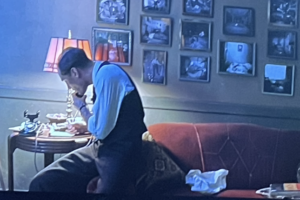Color-Love
With the midwinter landscape looking pretty drab, it’s this time of year that a fresh color scheme really perks me up. Nothing seems to lift my spirits more than beautiful colors.
Years ago when I moved into a white box of a city apartment, after days of unpacking, I began to feel unaccountably low-spirited. I knew I needed some color. It was weeks before I’d get around to painting so I turned to my artwork for inspiration. I had a large poster by Roy Lichtenstein (signed by the artist) which I impulsively hung at the end of my galley kitchen and suddenly – Wow! – the space came alive and I did too. Lichtenstein is far from being my favorite artist but the bold graphics and the primary colors were nothing short of a life-giving tonic to my standard issue white and brown kitchen.
Favorite Things and Color Schemes
Let’s talk color schemes. Nothing is more fun for me than to develop a color scheme. The possibilities are infinite, so infinite that some people don’t know where to begin. Start with what you have. Is there a piece of art or a bowl, a rug, a collection of shells, or a swatch of fabric that you just love? Sometimes you can pull a whole color scheme from a decorative plate. If you can’t think of anything look in your closet. Are there any outfits you particularly like? (A word of caution about the closet, however. Colors that are flattering to you are not necessarily colors that you want to dominate your environment; the dominant color is my wardrobe is purple but I’m not that keen on purple as a dominant color in a room).
Or start a project on color: find a good-sized container and start collecting colors that appeal: magazine photos, fabric swatches, driftwood, a particular color of stationery – anything you can collect or photograph. When you have a sizable collection, see what you have; what are the common threads? When my clients do this, I find that invariably there is a consistent theme that pulls their choices together. What are your common threads? Do you prefer all cool colors, all muted colors, are your colors all bright and clear, are you drawn to bright whites or off-whites, are you being drawn to new colors? Can you make a viable color scheme by combining your colors?
Color Properties
To plan a successful color scheme, it helps to know a little bit of color theory.
Color has three properties: 1. Hue – term used to describe the color (red, yellow, etc.), the color wheel is a tool used to show hues in relationship; cool colors on one side and warm on the opposite; complementary colors will be directly across the wheel; 2. Intensity – (or saturation) refers to the purity of the hue: the color in it’s purest form has the highest saturation; when mixed with gray or other colors, the color is described as softer, muted, or toned down: 3. Value – the lightness or darkness of a color: lightened colors are called tints and darker values are called shades. Colors close in value will have "soft edges" between them while sharp changes in value will create drama and excitement.
The property of value is probably the trickiest to discern because our eyes are influenced so much by the hue and intensity but value is important to keep in mind if you want to use different colors on the walls in adjacent rooms; if the values are close, the transition will be smooth. If you want a dramatic transition, varying values are the way to go.
Cool and Warm
Reds, yellows, oranges comprise the warm side of the color wheel while blues, greens and violet make up the cool side. Green kind of straddles the fence: olive green would be warm while a teal green would be cool. When people speak of a "cool red’ they are referring to a red that has a lot of blue in it – in other words, it’s approaching violet. A warm color scheme will generally be inviting as warmer colors are said to "advance" or make a room seem cozier. Cool color schemes will "recede" and I personally like to include at least a few "hits" of a warm color, say a few coral pillows on a blue sofa, to prevent the surroundings from becoming too chilly. People naturally tend to prefer light cool color schemes in a tropical climate and warmer darker colors in the north.
Dominants and complements
I find it works best to have one predominant in a room – usually the wall color. So, let’s imagine we’ve chosen a favorite color for a room, say it’s yellow and we’re going to use it in the living room. We’re aiming for a restful but fresh atmosphere. Let’s choose a creamy yellow for the walls. Creamy white or creamy yellow drapes will keep the feel consistent. I’d paint the trim and the ceiling in a bright white to give the room a crispness. Let’s bring in some muted spring green and again some creamy white for upholstery fabrics. The rug could be a lovely muted Oushak in golden beige and green. This gives us our basic palette: neutral whites and yellow and green which are analogous or next to each other on the color wheel. But we need some accents to bring it alive – artwork in warm muted tones framed in gold, warm woods or black frames would be a good addition. A bit of black such as a black coffee table makes the yellow "sit up and take notice" and warm tones of darker woods such as dark cherry, mahogany, or even oak will provide a nice contrast to our medium tone palette. Throw pillows and throws can add very effective spots of color. It’s always enlivening to bring in a bit of the complementary color – in this scheme a hit of dark eggplant (purple being the complement of yellow) might be just the right note.
Be aware of the effect of complementary colors; just a hint of the complement to a color will make the colors sing. Your basic complements are red and green, orange and blue, and yellow and purple. You will rarely see these used in their pure essence, but the basic hue is there; for example a terra cotta dining room will be brought alive by some blue plates.
Practical Notes
When you paint a sample color on the wall, be sure to paint white underneath and around it so you get the truest reading of the color. If you paint over another color it will skew the way your eye perceives it. In his classic book "The Interaction of Color," legendary artist and color theorist, Josef Albers, demonstrates how the same color appears changed when viewed next to different colors. Put paint samples on the walls, and paint them on different walls in the same room, because color perception is all about light, and the light on each wall will affect the color.
To get an idea of what bold colors look like on the walls, go to www.Benjaminmoore.com to view sample color schemes in room settings.
When buying paint, the finish you choose will also affect the color. Some people love the sheen of semi-gloss finishes and the practicality of the harder paint surface but the color will look very different in the light-reflecting surface of the glossy paint vs. the light absorbing quality of the flat paint. I specified a flat dark blue color for one of my clients and she was disappointed in the result; when I came by to inspect, it turned out that the salesperson in the store had talked her into a satin finish rather than the flat. She had to repaint the room, but we ended up with the result we wanted.
Current trends
Last month, I touched on a few trends in color. In your own home, I’d advise you to choose colors that you truly love rather than try to follow trends, yet what we see around us does influence us and broaden our color comfort zone. One popular influence now is what we might call "Global Reflections" – bright sari-inspired colors from India have shown up in fabric houses along with a palette of very hot colors from Brazil. Americans typically moderate the use of these colors by combining them with neutrals and using them in smaller doses than the originating culture!
The cool clean colors of the "Spa Life" appear to be popular for the foreseeable future. Cool blues, violets and greens are next to each other on the color wheel and thus make for a serene analogous color scheme which is associated with relaxation and figuratively "chilling out." This has a lot of appeal for our stressed out 24/7 culture. These colors are requested for a lot of bathrooms and bedrooms and, surprisingly, living rooms as well.
Earthwise, even though we are committed to living "green" that doesn’t mean our lives have to be devoid of color. In addition to the brown-based palette of the recent past, we are seeing more color derived from nature show up in green design – oceanic blues, leaf greens, oxidized reds and gold.
The world of high fashion usually filters into design six months to a year from it’s first introduction. Metallics made a re-appearance on the runway and now I find them shown in fabric for drapes and upholstery.
Whatever your color choices, have fun picking and choosing. It’s a great way to ward off the winter doldrums.






